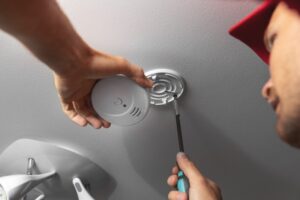Your gas furnace has a lot of different components. Some have purposes related to functionality: they help with the generation of heat. Some have purposes related to safety: they prevent things from going dangerously wrong. Your heat exchanger does both. It is critical to the function of the furnace, and it is also critical to your safety.
Sometimes, people postpone having furnace repairs done. If their home just isn’t getting quite toasty enough, or the heat doesn’t seem like it’s evenly distributed, they might feel like it’s not an urgent enough concern to address immediately. If you suspect that your heat exchanger is cracked, you absolutely must get it repaired right away. Here’s what you need to know.
What a Heat Exchanger Does
To create heat, your furnace combusts natural gas. This produces what are called combustion gasses, and they are very hot. To warm the air that will circulate through your ducts, it must be in close proximity to those hot gasses. But the air must also be kept separate from the gasses, so it isn’t contaminated and stays safe for you to breathe.
Enter the heat exchanger. The combustion gasses flow through it, staying safely inside. Air flows around it, absorbing heat to distribute throughout your home. Your house heats up and no risk is posed to you or your family. But what about when the heat exchanger is cracked?
Heat Exchanger Cracks
This component is made of metal. As your furnace cycles on and off, heating up and cooling down, the metal of the heat exchanger expands and contracts. It is made to be able to handle that for quite some time, but eventually, the wear and tear can get to it, causing the heat exchanger to crack.
Now the combustion gasses are able to escape and mingle with the air that will flow out your vents and be breathed. And those combustion gasses contain something very dangerous: carbon monoxide. Breathing that in can cause alarming symptoms like dizziness, blurred vision, vomiting, and even hallucinations. Breathing it in high enough concentrations can be lethal.
Preventing Carbon Monoxide Poisoning
The first way to avoid having this problem is to keep a close eye on your furnace. Have annual maintenance done by a qualified professional, who can spot warning signs early and let you know if your heat exchanger is at risk of cracking. And know the indicators of a cracked heat exchanger so that, if it does happen, you’ll be able to get heating repair in Plainfield, IL immediately.
- Pilot problems: A dancing, flickering flame, or a flame that is any color other than blue.
- Moisture: Excess condensation in your furnace, leading to dripping or puddles.
- Soot: A buildup of soot in your furnace cabinet from incomplete gas combustion.
- Clicking: The edges of a crack coming together as the heat exchanger cools down from a heating cycle and contracts.
- Odors: Some people describe the smell as being similar to formaldehyde.
- Corrosion: If you can see rust anywhere on your furnace, the heat exchanger may be rusting as well, increasing the risk of cracking.
The second way to keep yourself safe is to make sure you have carbon monoxide detectors installed and that they are regularly checked to ensure that they’re in good working order with fresh batteries.
Whether you want to schedule regular maintenance, have a question about heat exchangers or carbon monoxide detectors, or need repair urgently, we’ll always be happy to hear from you.
Call J&A today, Sleep-tight tonight!

